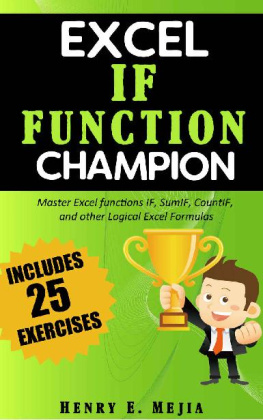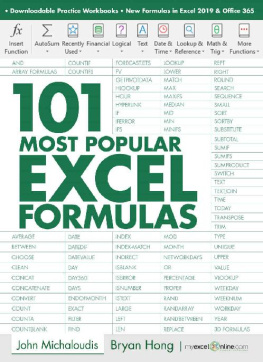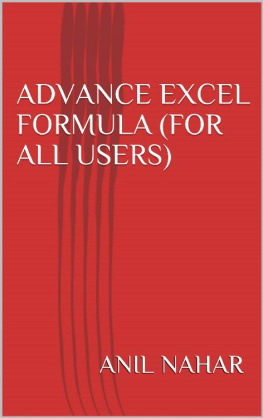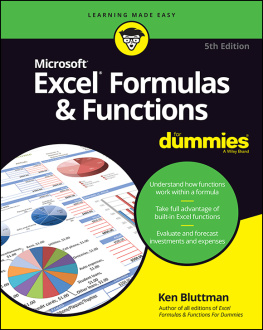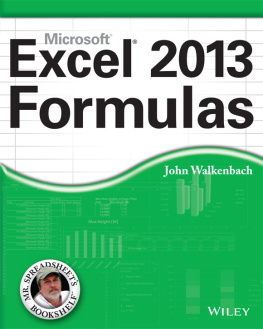EXCEL
IF FUNCTION
CHAMPION
(Excel Champions Series)
HENRY E. MEJIA
EXCEL IF FUNCTION CHAMPION
Copyright 2019 HENRY E. MEJIA
All rights reserved. No part of this publication may be reproduced, stored in any data retrieval system or transmitted in any form or by any electronic, mechanical, photocopying, recording or other means, without the prior written permission of the author, except in the case of brief reviews used in literary reviews and certain non-commercial uses provided by the Copyright Law.
ABOUT THE AUTHOR
Henry E. Mejia is an online entrepreneur who discovered the great benefit of knowing how to use Microsoft Excel at an advanced level, and now he devotes part of his time to creating courses (books and videos) so that more people can enjoy free time and better opportunities that an Advanced Excel user can have.
Henry also realized that the vast majority of people give away a lot of their life in front of the computer. That time could be used in more productive or more enjoyable activities, only if people knew how to use Excel a little better.
The goal of Henry's books is to open the door for workers and business owners to use Excel more efficiently, so they can have more and better growth opportunities.
THANK YOU
Thank you for getting this book. This book is all about showing you to use Excel IF function as fast as possible. I enjoyed a lot writing this book, so I really hope you enjoy yourself reading it, practicing and becoming an Excel Champion.
If you want to help the author produce more books like this one please leave your honest review about this book on Amazon
CONTENTS

OTHER BOOKS BY THE AUTHOR

THIS BOOK IS SO GREAT! NOW I CAN ANALYZE GIANT DATABASES WITHIN SECONDS! - Sales Coordinator of a Wholesale Company.
CLICK HERE TO LEARN MORE ABOUT EXCEL PIVOT TABLE CHAMPION

"THE ONLY EXCEL VLOOKUP FUNCTION BOOK YOU WILL EVER NEED" - Sales Manager of an Oil Products Manufacturing Company
CLICK HERE TO LEARN MORE ABOUT EXCEL VLOOKUP CHAMPION

THIS GREAT AND EASY TO UNDERSTAND BOOK TEACHES A VERY USEFUL WAY TO ANALIZE DATA" - Accounting Manager of a Sportswear Company
CLICK HERE TO LEARN MORE ABOUT EXCEL CONDITIONAL FORMATTING CHAMPION
INTRODUCTION
Welcome to Excel IF Function Champion. This book was written to teach you the correct way to use the IF Functions and other logical functions quickly and easily.
It is extremely important that you know that this book is not just about the IF function, it is actually a complete guide about the main logical functions of Excel, so with this book you will also learn to use the following Excel Functions:
- IF
- IFS
- OR
- AND
- SUMIF
- SUMIFS
- COUNTIF
- COUNTIFS
This book is part of the "Excel Champions Series and is written in a simple and clear language.
Many times, it is necessary to use reasoning to make decisions. In Excel there are the LOGICAL functions to make those decisions and then obtain a specific result.
These logical functions are what you must master to create formulas that make the reasoning process for you, saving time and effort. Additionally, Excel formulas can not be wrong if you write them correctly.
It's time to start your journey to become an Excel IF Function Champion.
GET YOUR 25 PRACTICE SPREADSHEETS (.xlsx)
Before starting Chapter 1 I recommend you get your 25 practice spreadsheets. Those exercise files are included for everyone who purchases this book. Those will help you at the end of each chapter to practice what you have learned and make sure you have learned it well.
All you have to do is to send me an email to:
ems.online.empire@gmail.com
With the Subject IF FUNCTION PRACTICE SPREADSHEETS and saying:
"Hello, I bought your book EXCEL IF FUNCTION CHAMPION and I need the 25 practice spreadsheets"
I will gladly reply your email and send you the files.
Now you are ready to start Chapter 1. Lets go!
CHAPTER 1
WHAT IS A FUNCTION AND WHICH ARE ITS BENEFITS?
(CHAPTER FOR BEGINNERS)
This chapter is written as an introduction for those who have no knowledge of Excel Functions and for those who have some knowledge but find it a little confusing yet. If you already know how to use some other excel functions, you may need to skip this chapter, although it would not hurt to review it.
An Excel Function is a way to carry out some operation in Excel. They are also called FORMULAS.
EXCEL FUNCTIONS = EXCEL FORMULAS
Microsoft Excel divides the functions into groups, and the main ones are the following:
Financial
Logical
Text
Date and Time
Lookup & Reference
Mathematical & Trigonometric
The IF Function (and most of the formulas we will study in this book fall into the LOGICAL category)
ADVANTAGES OF FUNCTIONS
The biggest benefit of the functions is that you can save a lot of time since the Excel can automatically perform reasoning such as:
Decide WHAT to write if a certain condition is met
Decide WHAT to write if the condition is not met
Decide WHAT operation to do depending on the situation
Decide WHEN to add and when NOT
Search for specific data
Decide WHERE to look for this data
Decide WHEN to look for this data
And many other operations that you do not need to do manually if you know how to use Excel Functions
WHERE DO I FIND THE FUNCTIONS I CAN CHOOSE?
Option 1: Look for the Formulas tab and there you can find them divided into categories.

Option 2: Click on the FX button located to the left of the formula bar. And you will be shown a box with all the formulas.
Option 3: Write the formula directly in the formula bar.

WHICH ONE IS THE BEST OPTION AND WHY?
I sincerely believe that Option 3 (write the formula) is better because with some practice you learn the Arguments (Parts) of each formula, plus it is faster to add the formulas by writing them.
WHICH ARE THE PARTS OF A FUNCTION?
The functions always start with the equals symbol (=) followed by the formula name (for example IF) followed by the parts of the formula (also known as arguments). The arguments are separated by a comma (,) in case the function has several arguments.
For example, the IF formula has 3 arguments and to use it would be written like this:
=IF(argument1,argument2,argument3)
Obviously instead of writing argument1,2 and 3 you need to use other parameters but I will explain exactly how it works in the next chapter.
At this moment my main intention is that you understand that the Excel functions always have the format of =NAMEOFTHEFORMULA (arguments) and without any space in the whole formula!
QUICK CHAPTER SUMMARY:
Next page
